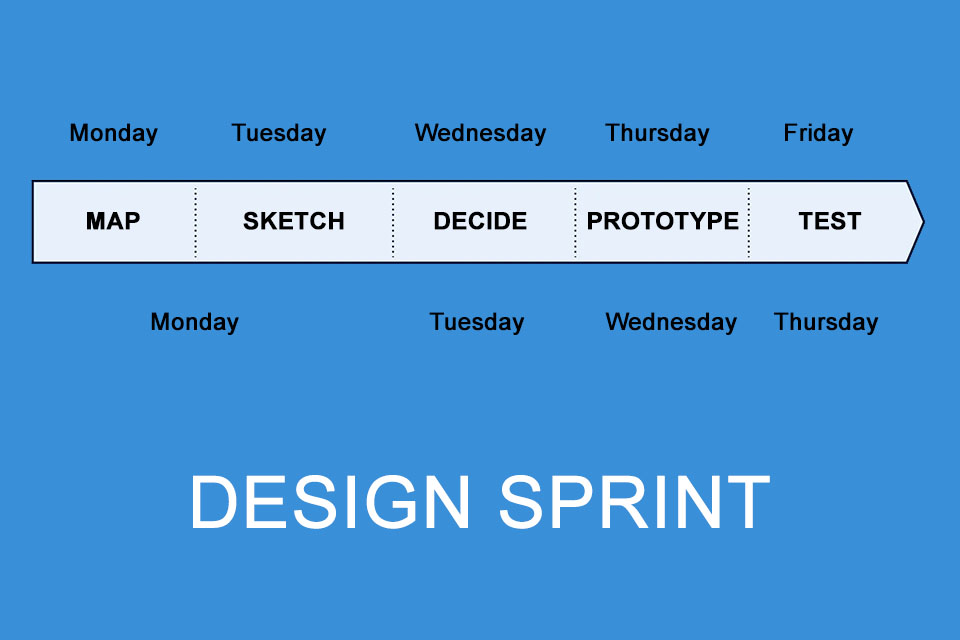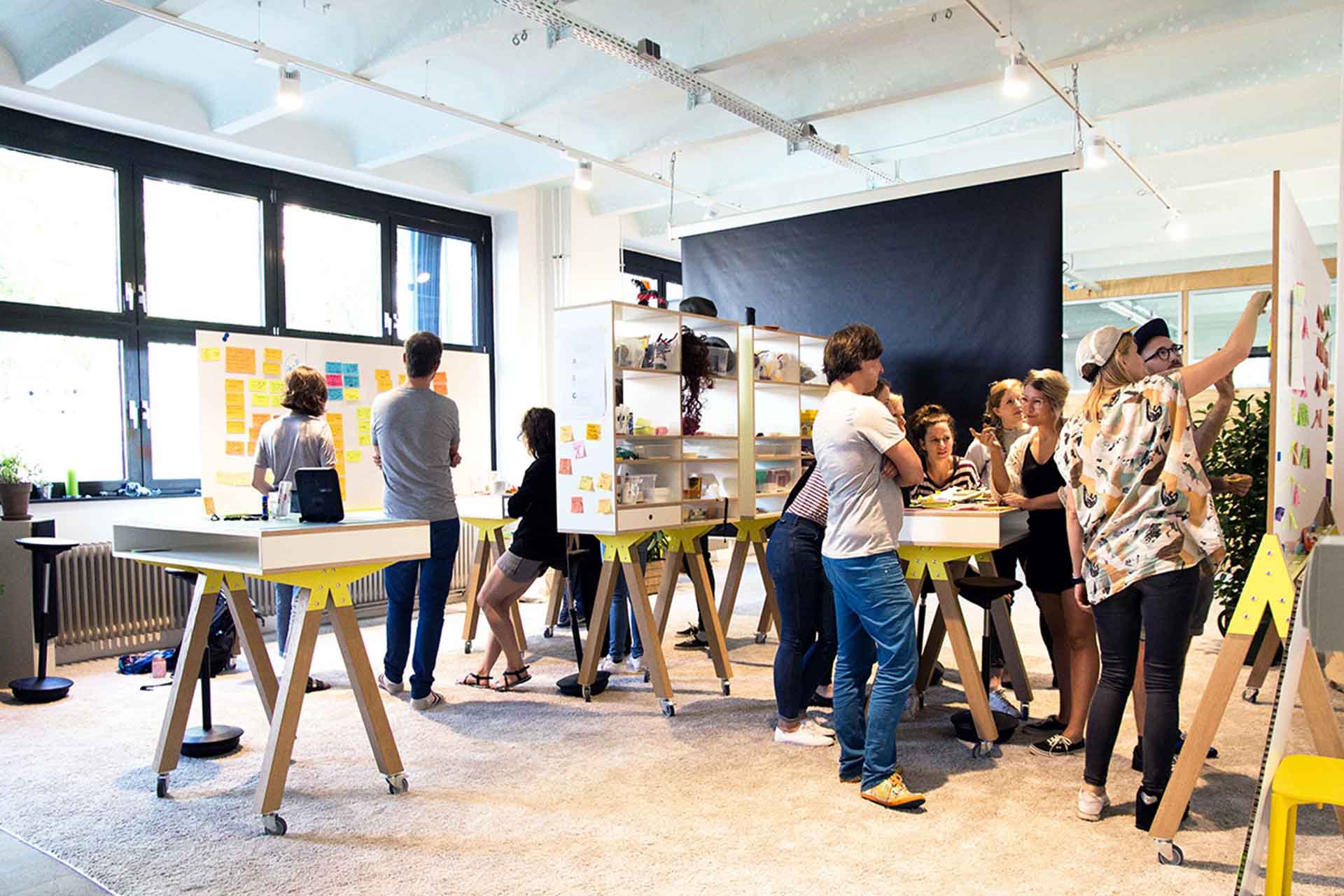What is Design Sprint?
Table of Contents: Definition – Methodological Borrowings – Process – Application – Advantages – Notes
Design Sprint – The accelerated innovation process
In a world that is constantly evolving, the ability to quickly develop and implement innovative solutions is a critical success factor for companies. Many companies encounter complex problems for which conventional approaches are often too time-consuming and deliver only inadequate results. This is where the Design Sprint method helps as an agile, time-defined, structured innovation process that makes it possible to develop a prototype for solving a challenge, test hypotheses and validate concepts at short notice through customers.
The Design Sprint method1 was developed by Jake Knapp, a former Google Ventures Design Partner. Together with John Zeratsky and Braden Kowitz, he published the book “Sprint: How to Solve Big Problems and Test New Ideas in Just Five Days”2.
The methodological borrowings of Design Sprint
Design Sprint combines elements from Design Thinking, Customer Journey and Scrum, with the aim of developing a solution for a problem in the short term and validating it with the help of a prototype by customers.
The term ” Sprint” in the Design Sprint method was taken from Scrum. Scrum is a framework with events, accountabilities and artefacts for the development of complex products and services. The Sprint in Scrum refers to an iteration of consistent duration and similar actions, with the ambition to realise an increment within the iteration. Jake Knapp transferred the term Sprint into his approach to emphasise a similar, time-limited and intensive way of working. The Design Sprint usually lasts one working week, which is a much more compressed period compared to the longer Sprints in Scrum, which can last up to four weeks. The aim of the Sprint is to focus the team and make progress quickly.
Elements of a Customer Journey can also be found in the Design Sprint method. The Customer Journey describes the collected experiences of a customer with a service, product, brand or company, from the moment of initial interest to the purchase and subsequent use. It is a concept that maps the different stages and touchpoints a customer goes through while interacting with a product or service. The idea that both approaches share is a user-centred approach: both the Design Sprint method and the Customer Journey place great emphasis on understanding the needs and perspectives of users and incorporating them into the development process. By focusing on users and considering their interaction points, needs and experiences, both approaches aim to develop products and services that are truly relevant and valuable to the target audience.
Last but not least, Design Sprint incorporates many approaches from the Design Thinking method. It is based on the principles and techniques that designers use to iteratively develop innovative and functional solutions. Design thinking also looks at the problem from the user’s perspective. The goal is to understand the needs, desires and emotions of customers, and the process emphasises the active participation of users by collecting feedback and considering experiences.
The process of the Design Sprint method
A Design Sprint is a process carried out during a working week, with each day having a theme:
- Monday: Map – name the problem, set the goal
- Tuesday: Sketch – gather inspiration, sketch ideas
- Wednesday: Decide – evaluate ideas, create storyboards
- Thursday: Prototype – create prototype, set up user tests
- Friday: Test – test prototype, gather feedback.
This process is also known as Design Sprint 1.0.
Based on the experience of running corresponding Design Sprint workshops, Jake Knapp further developed the framework into Design Sprint 2.0:
- Monday: Map & Sketch
- Tuesday: Decide
- Wednesday: Prototype
- Thursday: Test
Instead of five days, the Sprint process now takes only four days. In some publications, this is seen as evidence of increased efficiency.3 In fact, however, it can make sense to plan five days for the process, for example if the task seems particularly complex or the people involved have little experience with the process.4
Let’s take a closer look at the contents of the individual days:
Monday: Outlining problems and solutions
On the first day, the participants try to develop a common understanding of the problem to be tackled, talk to experts and collect ideas for solutions. The aim is to understand the project and its requirements, and to establish criteria for success.
There are a number of methods for ideation5, for example
- the classic brainstorming,
- non-verbal brainwriting or
- 1-2-4-All.
And there are a number of useful questions, such as.
- For which problem are we looking for a solution?
- What are the unanswered questions or uncertainties about the project or product?
- What is the customer journey of our target group? What steps, interactions and touchpoints are there?
- Which people are involved in the customer journey and how do they interact?
- What processes and procedures are associated with the customer journey?
- Which external experts, colleagues or stakeholders could contribute valuable knowledge and perspectives?
- What aspects could external participants shed light on to deepen our understanding?
- How could we improve the customer process to increase satisfaction?
- How could we minimise or circumvent potential risks?
- How could we use innovative approaches to address specific challenges?
These and similar questions ideally help to develop a deep understanding of the problem, identify challenges, broaden perspectives, outline a customer journey map and possible solutions.
In practice, it has proven useful to categorise and then prioritise the answers to the questions. Both also help to clearly define a sprint goal that will guide the work throughout the week.
Tuesday: Selecting and refining solution ideas
On the second day of the design sprint, the participants discuss and evaluate the collected solution ideas. The goal is to select an approach that will then be prototyped and evaluated. This phase usually takes a lot of time because a comprehensive evaluation of all ideas in their entirety is essential. Various decision-making techniques, such as dot voting or point voting, are helpful.
In the further course of the day, the participants devote themselves to the elaboration of storyboards for the selected solution approach. Storyboards help to illustrate and explain complex concepts. If it is possible to depict the customer interaction from the customer’s point of view, the understanding of the requirements ideally increases, new aspects come to light and the common perspective is promoted.
Wednesday: Converting the solution approach into a prototype
The third day of Design Sprint 2.0 (in version 1.0 it would be the fourth day) is about developing a prototype. Various techniques are available here, such as working with wireframes (as a framework).
- Wireframes (as a framework for an information architecture and visualisation of a navigation and user interface),
- Click Dummies (as clickable prototypes with a very small range of functions that enable rapid user feedback) or
- paper models (to illustrate process or service flows).
In practice, it is advisable to think through and prepare for subsequent testing by users.
Thursday: Testing and validating the prototype
On the last day of the Design Sprint, the developed prototype is tested by a group of users. Here it can be useful
- use a structured questionnaire per user,
- to listen actively
- filming the use of the prototype (with permission, of course).
On the one hand, it is about observing the interaction or the user experience live in order to identify possibilities for improvement, on the other hand, the users are ideal partners to (better) understand expectations and requirements. The aim is to gain a secure level of knowledge about the project’s chances of success.
When is the application of Design Sprints particularly useful?
Design Sprints are used in many industries and sectors, and the approach makes sense when
- a company wants to develop a new product or service to quickly generate innovative ideas and get early feedback from potential users,
- a team is faced with a complex problem and is looking for solutions that they want to test quickly,
- a company wants to explore new business opportunities and validate them in the very short term.
It is important to note that the approach is not equally suited to every project or challenge. Smaller tasks or problems that are already well understood can be solved more quickly using other methods. Design Sprints make a lot of sense when solving complex, ambiguous or high-risk challenges that require innovative ideas and rapid validation.
What are the advantages of the Design Sprint method?
The use of Design Sprints offers a number of advantages over other variants for developing prototypes:
- Design Sprints usually last only four or five days, which means that a working prototype can be developed and tested within a week. Other approaches, such as the development of a Minimum Viable Product (MVP), often take more time.
- The approach ideally brings together interdisciplinary teams and encourages the active participation of all members. This enables intensive and focused cooperation that can lead to creative and innovative ideas. The prerequisite for this is often an experienced facilitator.
- One focus of the approach is on the needs and perspectives of the users. The prototype is tested with real users early on to get valuable feedback and improve the user experience.
- By developing and testing the prototype quickly at an early stage in the process, potential problems and risks can be recognised and addressed early on, before too much time and resources are invested.
- The approach helps to make quick decisions and gain clarity on which solution is most promising, as all team members are actively involved in the process.
- Last but not least, the Design Sprint method provides a clear structure and a fixed timeframe, which facilitates collaboration and organisation and helps the team to move forward quickly.
To reap these benefits, organisations should ensure that the problem is well defined and that the team is working towards the same goal. Active involvement and encouragement of all stakeholders is also important. In addition, it is important that all stakeholders are available all the time and the goal is to validate a solution approach that does not have to be perfect, but provides a clear indication for the future of a product or service.
Impulse to discuss
How important is it for the success of the method that it starts on a Monday and not, for example, on a Thursday?
If you like the article or would like to discuss it, please feel free to share it in your network. And if you have any comments, please do not hesitate to send us a message.
[1] As is so often the case, opinions vary as to whether the approach is a framework or a method. Design Sprint is often referred to as a framework because it provides a structured and flexible structure that enables teams to solve complex problems quickly and effectively and develop innovative solutions. At the same time, it is also a method because it provides a specific, systematic approach to delivering projects. It combines elements from proven approaches to manage a process and support teams to generate creative ideas, develop prototypes and gather feedback. And a process it is, of course.
[2] Sprint: How to Solve Big Problems and Test New Ideas in Just Five Days
[3] In both the four- and five-day versions, it can be useful to arrange a preliminary meeting to discuss the problem to be solved in advance, to address possible objections and to explain the procedure. In addition, the distribution of tasks in advance is also conceivable. Interestingly, few sources add this preliminary meeting to the duration of the process.
[4] In practice, it can be difficult to take everyone involved out of the operational business for four or five days. Therefore, there are also organisations that conduct an entire design sprint in a single day; of course, in many cases the result is likely to be somewhat less meaningful, but the insights could still be valuable.
[5] Take a look at more ideation methods.
To prepare for a Design Sprint, you can find various information here:
And here you can find additional information from our t2informatik Blog:



